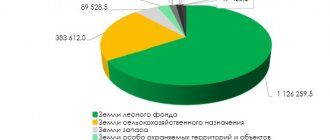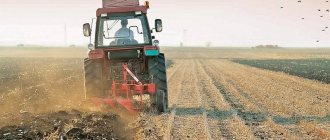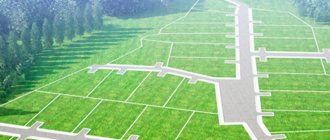Pravozhil.com > Real estate registration > Reserve lands are territories not encumbered with economic purposes
Reserve lands - what is it, let's understand the terminology. The chapters of the Land Code reflect information on existing categories of land according to the target profile.
The legal aspects of the main six appointments are clear and understandable:
- land for farming
- territories of cities and towns
- areas for the conservation of especially valuable natural areas
- forest lands
- lands of reservoirs
Reserve lands are a reserve category
What are reserve lands? Reserve lands are the seventh special category. From a legal point of view, the essence of land in this direction is poorly and vaguely described; their purpose, unlike other categories, is not indicated.
The reserve lands do not have a sufficiently clear description. The scope of their use does not have strict restrictions.
Lands are allocated according to the following formal characteristics:
- belonging to state funds or local governments;
- lack of owners of land plots;
- a ban on the use of the territory until the category is changed or transferred to someone else's jurisdiction.
Thus, in fact, the purpose of reserve lands is a soil reservation, not burdened with economic exploitation for human needs.
In the unified register of territories of the Russian Federation, empty spaces make up a third of the area or 6.4% of the country’s total fund.
Reserve lands are often unused, which means uninhabited. These include lands of undeveloped territories. For example, regions in the Far East, the Far North and Siberia, Altai Territory.
In the Central part of the Russian Federation, reserve lands occupy an insignificant place among other categories, although they are present in all subjects of the Federation.
Despite the “no man's land” of the sites, certain geodetic, survey, cadastral, and prospecting works can be carried out in agreement with the authorities.
Land reserve is a territory awaiting the needs of society in free development zones. The boundaries of reserve lands are flexible and change depending on the transfer of plots to other categories as they are in demand, developed and intended purpose.
It is impossible to occupy seemingly “free” lands on your own. Casual users and local residents often arbitrarily develop the territory.
If there is no major construction on the site, local authorities sometimes put up with vegetable gardens and plantings. They turn a blind eye to the use of reserve lands for agricultural purposes.
How to obtain permitted use of a land plot
The method of changing the category is standardized by law and described by regulatory documents. According to which there is a certain procedure:
- Determination of the authority that decides on the target change in the use of the site.
- Preparation of an application and collection of documents.
- Registration of property rights, taking into account the main purpose of the territory.
Legislation has changed frequently, resulting in confusion and lack of data. If there is a lack of cadastral data, they are taken from documents certifying ownership. The issue of the category of a site is initiated by the owners, and the decision to assign a category is made by the authorities.
If the necessary information is not provided by the land act, certificate and cadastre, then the purposes of land use are determined by the local council.
The authority to assign and change the category of state lands in Moscow and St. Petersburg, and change the boundaries of plots belongs to the Federal Government.
In other cases, the use of reserve lands and their transfer to another category are regulated by municipal or regional authorities. Regional authorities can transfer rights to the municipal level.
It should be noted that changes regarding village and intra-city areas are carried out by decision of local authorities. The lands are managed by the municipality. Owners and landowners are not involved in resolving the issue.
The rules apply to regions where land is not divided between federal and regional authorities. If division exists, then the unused lands are at the disposal of the relevant authority.
We suggest you familiarize yourself with: Documents to prove the rights of the new creditor
When obtaining the right to use such property, you must comply with all established rules. Thus, there are three conditions that allow the use of land without transfer to another category of ownership. This is possible if:
- The territory is not located in the range of closed formations. Objects located on it can be used to your advantage.
- The area is used for hunting and driving livestock to pasture.
- If the collection of dead wood is organized on the site, then there is no need to transfer it to another category. However, it is prohibited to use dead wood for the purpose of making monetary profit.
In any other case, it is necessary to transfer the plot from one category of ownership to another.
Transfer of a land plot from reserve to another category is allowed in exceptional cases when an urgent need arises. Such cases include:
- It is necessary to realize a territory with special protection, after which a natural park or reserve will be created.
- It is necessary to change the existing territory of the borders of the country's subjects.
- Conservation of the land plot is required due to its deterioration.
- It is planned to construct elements of infrastructure or other useful purposes for the community.
- Raising the level of state security through the construction of new military bases.
- Discovery of a new mineral deposit.
The Land Code provides the most precise definition that allows us to characterize the significance of reserve lands. This procedure for forming reserve lands, familiar to every specialist, was considered from several points of view.
This includes land plots that were recently removed from the general use category:
- lands that are intended for agricultural purposes, but cannot be used due to low fertility;
- Other land use that can be used for agricultural purposes should be included in this category. A region may impose a ban on the exploitation of areas that are in reserve for further cultivation and processing procedures. It is imperative to carry out all the necessary calculations regarding the harvest figure that will be obtained this year. The products must be sufficient to meet the domestic needs of the country, as well as for supplies abroad;
- a number of land fragments that are used by the forest fund with dense vegetation. It is prohibited to use such territories, since they are reserved for further construction work, as well as the construction of other engineering facilities;
- land on which bodies of water are located. It is not possible to use such areas due to their unsuitability.
Exceptions to the rules can only be a variety of recreational options.
Reserve lands can be divided into several main categories, depending on the degree of subordination of resources, as well as the general level of ownership:
- federal states. On the territory of such land plots there are important objects of national importance, or separate areas with objects privatized on the territory. Until the procedure was completed, the land was the property of the country;
- objects of the Russian Federation, which include all the numerous areas that were included in the territorial boundaries of various municipalities that are located on the territory of this state entity. They can also be included within the strict boundaries of a separate entity, on the territory of which real estate was located, which before privatization was listed in the use of the state;
- land plots of various municipalities. This category includes territorial entities that have absolutely no divisions into federal or regional levels.
The use of the above categories of land can be carried out only if there is a need for it, and the land can also be transferred to another category of land plots that comply with the current legislation of the country.
Rules for the use of land plots
These lands can safely be classified as land that exists on the territory of the state and in order to carry out the general process of exploitation, rules must be followed that allow or, conversely, prohibit the use of these resources.
It is allowed to use the land without transferring it to another category, but this is only possible if:
- the land was not included in the general list of closed territorial objects and then each natural object that exists on it can be exploited according to one’s personal interests. This usually applies to lands that should be classified as so-called reserve lands, and a river may flow through these lands, in which pike is found and fishermen are allowed to catch it. It's simple, this type of fish is not classified as prohibited, so this is possible;
- you can use the land for hunting, driving livestock to your grazing place without stopping at this territorial object;
- land that cannot be classified into any of the above categories is allowed to organize the collection of dead wood. At the same time, there are absolutely no restrictions regarding the cutting down of green spaces. Typically, dead wood is used to heat houses, but certainly not for additional profit.
It is allowed to exploit reserve lands, and they must first be transferred to a separate category or completely dispensed with. Operation is possible only in three main cases, which were listed above.
What should be the order of translation for each category?
We invite you to familiarize yourself with: Legal acts regulating the activities of the enterprise
It is fixed at the federal level and should include:
- the need to create a territory taking into account special conditions that directly relate to the mode of operation, as well as protection;
- the need to change the boundaries that have been established, and also try to distinguish new administrative entities;
- try to carry out the process of land conservation due to their general wear and tear, for example, if the level of fertility of agricultural areas has been reduced;
- the likelihood of constructing objects that should be classified as engineering infrastructure for social or domestic purposes;
- ensuring maximum security of the country and each of its borders;
- development of territory with minerals, as well as other procedures for their extraction.
This list is currently exhaustive, and any changes and additions to it can only be made through the process of adjusting the current legislation.
It is possible to use the territories only after the land has been transferred to one of the categories. From a legal point of view, this must all be formalized correctly. The general procedure for transferring land into one of the categories allows regulating the federal law of the same name.
If we consider the presented law from the point of view of the general details of the procedure algorithm, then it is worth highlighting several stages:
- the first involves filing a petition to change the categories of land, and the level of filing such a written petition will be of particular importance. It is determined by whether the land plot belongs to the state or to some other entity. If the territory is the property of the country, then the petition should be submitted directly to the Government, considering the issues of the subjects - sent to the executive body at the regional level, or to a municipal entity - to the municipal body;
- thanks to the second stage, it is possible to prepare all the necessary documentation that is necessary to confirm the previously made decision on the request to transfer the land plot from one category to another. To do this, it is necessary to collect a complete package of all papers that will confirm the use of this land for specific purposes;
- the third stage is a check, after which a harsh verdict will be issued, allowing the transfer of land from one category to another, or a refusal with an explanation of why this cannot be done.
There are specific rules for the use of state reserves and they strictly define in what cases resource lands are allowed to be used. Without changing the category of reserve lands, they can be used for the following needs:
- in the interests of the population of adjacent territories, if the area of the reserve site is not a closed area. An example: a river flows through a site, there is a catfish in it, and a citizen has the right to catch it, because there is no ban on catching such fish. This means that fishing in the river in this area is allowed;
- You can also hunt on the territory of the reserve fund and drive a herd of domestic animals through this area to pasture areas; stopping during the drive is prohibited;
- Work on felling dead trees without cutting down living trees is also permitted, provided that such logging is carried out in the form of creating a supply of firewood for one’s own use, and not for commercial purposes.
Dynamics of the territory
There are factors that contribute to changes in the area of reserve lands, both up and down
Reserves are continuously replenished or reduced depending on legislative decisions.
Reserve territories are increasing due to:
- return at the end of the period of use;
- voluntary refusal to develop the territory; avoiding the need to use sites;
- seizure for violation of the law;
- lands taken out of economic circulation, etc.
The decrease in the land reserve fund occurs as a result of decisions made about:
- creation of trust funds;
- providing plots to Cossack societies;
- resettlement of refugees and accommodation of internally displaced persons;
- about housing construction;
- farm organizations;
- formation of cooperatives, etc.
Does not apply to stocks
Plots abandoned by owners are not included in the described territories. Despite the homeless nature of the territories, the rights of the owners to them are preserved until changes are registered in the land cadastre documentation.
Only an official refusal can become the basis for changing the category of land allotment.
The conservation of these places is also not a basis for classifying them as reserve lands. Landowners temporarily exclude soil from economic use due to contamination with toxic industrial waste and land degradation.
Not all abandoned land plots are included in the described areas.
The identification of the redistribution fund with the places described is also erroneous. The Land Code specifies a list of grounds for creating a fund only from agricultural areas.
Legal regulation and rules for the use of redistribution lands are related to the goals of protecting and studying natural resources.
Replacing categories
The replacement rules are regulated by the Federal Law and carried out by the authorities:
- Government of the Russian Federation - for plots that are federal property;
- executive power on the territory of constituent entities of the Russian Federation - for agricultural lands owned by business entities or privately owned;
- local government - for lands that are municipal property (excluding agricultural land) and private holdings for various purposes.
Replacing the purpose of land in residential areas and, conversely, transferring any plots to the land fund for settlement and subsequent development is regulated through the placement of the boundaries of residential areas within the framework of the Land Code and legislation in the field of urban planning.
Replacement of land categories may occur under the influence of certain economic or demographic factors.
Legislative level
Since the form of ownership in which the reserve lands are located belongs to a special category of land plots, there is a separate bill regulating the legislative features of such property.
Detailed regulations regarding such real estate can be studied in Article 103 of the Land Code of the Russian Federation. The Federal Law “On the transfer of land from one category to another” also plays a significant role. Plus, in some regions of the state you may encounter legislation at the subject level.
According to Article 103 of the Land Code, areas that can become reserve land can be identified:
- Unused areas intended for agricultural work.
- Agricultural land that does not need to be put into operation. During this time they are in the register of such property.
- Territories at the disposal of the forest fund.
- Areas where natural bodies of water are located.
In general, reserve lands include lands located around all populated areas. Most of these plots belong to a special category of ownership form.
The reserve lands are managed by an authorized state body. Which one depends on the degree of subordination of real estate to any level of ownership. There are three possible types of such property:
- Federal territories. These are places where federally important facilities are located. Only the highest state bodies manage such property.
- Regional property.
- Municipal land.
Exploitation of reserve land is permitted only when absolutely necessary. However, first you need to transfer the site to the appropriate category of property.
Procedural features of replacing the category of reserve lands
The procedure for changing the category of reserve lands must be preceded by a state environmental assessment of the territory
The beginning of preparing a package of documents to change the category of a plot of land is to draw up a petition to government agencies or municipal authorities.
The applicant must provide information:
- about the cadastral number of the land plot;
- about categories of land (real and the one to which the transfer is being made);
- about the reasons for changing the category;
- from the Unified State Register about the non-ownership of the site by anyone;
- from the State Cadastre on the inclusion of a site in the category of reserve lands;
- on conducting a state environmental assessment.
A refusal to apply for a change in land category can be obtained if the content of the application or attached documents contradict the norms of the law. The applicant will receive a refusal certificate, which can be appealed in court.
In case of a positive decision, the act records the decision to assign the requested category of land.
The document reflects:
- reasons for changing the category;
- dimensions and boundaries of the site;
- cadastral number;
- indications of the old and new categories.
The category of land in reserve is subject to replacement upon application through lengthy and thorough procedures. The help of specialists significantly speeds up the process and makes it possible to turn abandoned land into a useful area for everyone.
What categories are possible for reserve lands?
Legislation allows the transfer of reserve lands to the following target categories:
- for development and placement of populated areas;
- for the construction of industrial facilities, production development;
- for the purpose of preserving valuable natural areas, for example, nature reserves;
- for the purpose of conducting agricultural work, including the necessary communications, plantings, facilities for processing products, roads;
- for the conservation of forest and water resources.
Russia has large reserves of land that have yet to be used in economic life and the lives of new generations have to be built on them.
For more details about lands for various purposes and their use, see the video:
The concept of reserve lands and their features
In fact, reserve lands include land plots that are not used by anyone at all. They cannot be the property of organizations and individuals, but belong to the state or municipality.
The distinctive features of such plots include the following:
- they are not used by anyone;
- the plots are actually registered properly and have the necessary details;
- the boundaries of the plots do not have to be agreed with the neighbors;
- their subsequent use is not subject to urban planning regulations, since it is unknown how the plots will be used in the future;
- subsequently the allotment can be transferred to any category in accordance with current legislation.
In practice, most often, territories classified as “spare” are located outside populated areas, for example, abandoned agricultural lands that are not used due to decreased fertility. There is also a separate subcategory - lands that have never been used by anyone before.
In simple terms, reserve lands include those that are not actually used. In urban areas, such plots are practically never found, since there are no free territories at all.







